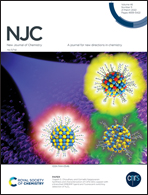Nucleation and growth mechanism of dendrite-free Ni–Cu catalysts by magneto-electrodeposition for the hydrogen evolution reaction†
Abstract
Developing high-efficiency electrocatalysts for the hydrogen evolution reaction (HER) is of great importance. In this paper, dendrite-free Ni–Cu catalysts were synthesised via one-step pulse electrodeposition under a weak magnetic field (0.5 T). Regardless of the direction of the magnetic field, the ions were affected by the magnetohydrodynamic (MHD) effect, which greatly promoted the mass transfer and dispersion uniformity, and suppressed the uncontrollable agglomeration by electrodeposition. It was found that the nucleation mechanism changed from progressive nucleation under a 0 T magnetic field to instantaneous nucleation under a 0.5 T magnetic field. Large-scale (325 nm, 0 T) dendrite growth on the single-sided plane was successfully suppressed, and replaced by smaller (90 nm, 0.5 T) and uniformly distributed cluster growth around the carbon paper. In addition, the (111) plane was strengthened by the magnetic field. Electrochemical analysis showed that the Ni–Cu catalysts exposed more surface area and exhibited greatly enhanced catalytic activity, which only needed −57.3 mV to deliver the current density of 10 mA cm−2 with a small Tafel slope of 99.4 mV dec−1 in 1 M KOH. Overall, magneto-electrodeposition, especially under weak magnetic field conditions, provides great promise for the preparation of HER catalysts.



 Please wait while we load your content...
Please wait while we load your content...